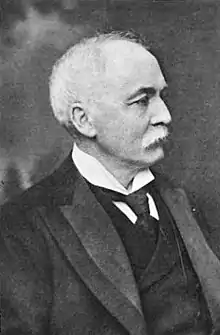
Sir William Bilsland LLD (17 March 1847 – 27 August 1921) was a Scottish baker who owned one of Scotland's largest bakeries, and was Lord Provost of Glasgow. He was an elder of the United Free Church of Scotland and a supporter of the temperance movement.
Life
He was born on 17 March 1847 at Ballat near Balfron, the son of Ann Blair and James Bilsland, a farmer.[1]
He was educated at Dalmanoch school in Bonhill living there with his uncle, Dr Alexander Leckie.
From 1860 to 1869 he worked as a grocer's assistant in Glasgow. In 1869 he opened a shop at 223 Garscube Road.[2] In 1872 he opened a bakery in Greenhill Street and also acquired an existing bakery in Elderslie Street.[3]
Bilsland Brothers

In 1877, with his brothers, he bought a large piece of ground on Hydepark Street and on which they built the large Hydepark Bakery, adopting the company name of Bilsland Brothers.[4]
By 1900 they employed 200 people and made 230,000 loaves of bread a week, over 10 million loaves per year. They supplied 1600 retailers. Workers were well-paid, worked a 40-hour maximum week, unusual for the time, and all received free bread.[5]
In 1912 they acquired the rival company of Gray and Dunn (but retained their name as Gray Dunn & Co).[6] The main company was rebranded as Glasgow Bakeries.
The company traded until 1985. The bakery was demolished in 2015.
Politics
In 1886 he became a town councillor representing the 13th ward (Anderston) in Glasgow.[3]
In 1905 he was elected Lord Provost, succeeding John Ure Primrose. As Lord Provost, he was the Lord Lieutenant for the City of Glasgow.[7] He served until 1908 during which time he saw many artistic projects, in particular the Kelvingrove Art Gallery and Museum. During this period he lived at 28 Park Circus[8] a beautiful, three-storey Georgian circus form, just east of Kelvingrove Park.
In 1907 King Edward VII created him a baronet, as Sir William Bilsland, Baronet of Park Circus, for his services to Glasgow.[9] He was appointed a Deputy Lieutenant of Lanarkshire in 1907.[10]
He was a trustee of the National Galleries of Scotland for three 5-year terms from 1907.[11][12][13]
He died on 27 August 1921.[14]
Family
In 1885 he married Agnes Anne Steven (d.1935). Together they had two children, Agnes Anne (1896-1970) and Steven Bilsland, who inherited the business on his death.[15]
Arms
 |
|
References
- ↑ Oxford Dictionary of National Biography: William Bilsland
- ↑ Glasgow Post Office directory 1872
- 1 2 "Bilsland Brothers". www.gracesguide.co.uk.
- ↑ "Sir William Bilsland". www.glasgowwestaddress.co.uk.
- ↑ "Sir William Bilsland, 1st Bt - Great British - bringing you closer to our history makers". great-british.co.uk.
- ↑ "Sir William Bilsland – Balfron, Stirlingshire". www.balfron.org.uk.
- ↑ "No. 11783". The Edinburgh Gazette. 5 December 1905. p. 1257.
- ↑ Glasgow Post Office Directory 1905
- ↑ "No. 28083". The London Gazette. 26 November 1907. p. 8188.
- ↑ "No. 28084". The London Gazette. 29 November 1907. p. 8334.
- ↑ "No. 28009". The London Gazette. 2 April 1907. p. 2271.
- ↑ "No. 28595". The London Gazette. 2 April 1912. p. 2393.
- ↑ "No. 30017". The London Gazette. 13 April 1917. p. 3493.
- ↑ "Sir William (1st Baronet Bilsland, of Park Circus, Glasgow) Bilsland b. 17 Mar 1847 Ballat, Balfron, Stirllingshire, Scotland d. 27 Aug 1921: The Douglas Archives". www.douglashistory.co.uk.
- ↑ "The Hidden Glasgow Forums • View topic - Bilsland's Bakery". www.hiddenglasgow.com.
- ↑ Burke's Peerage. 1915.
External links
- 1965 documentary Bilsland Bread, National Library of Scotland
- Derelict bakery building prior to demolition